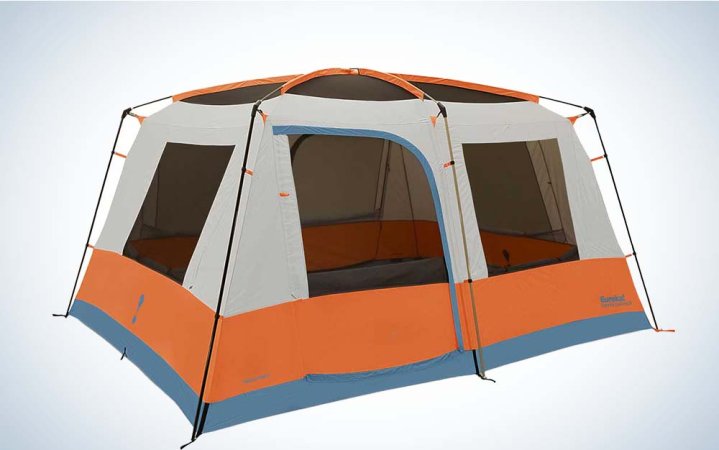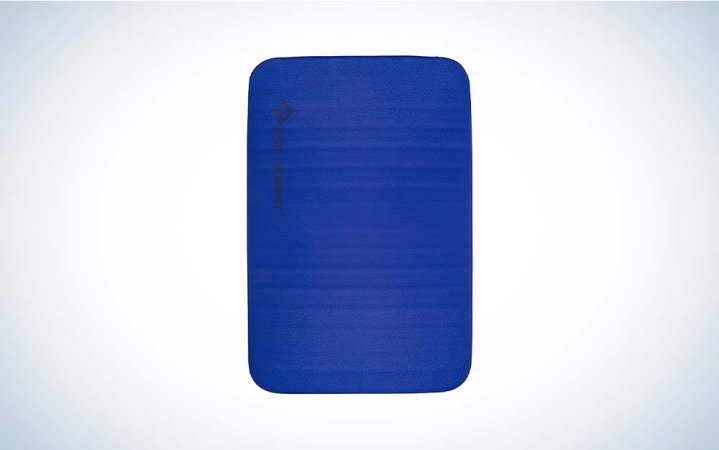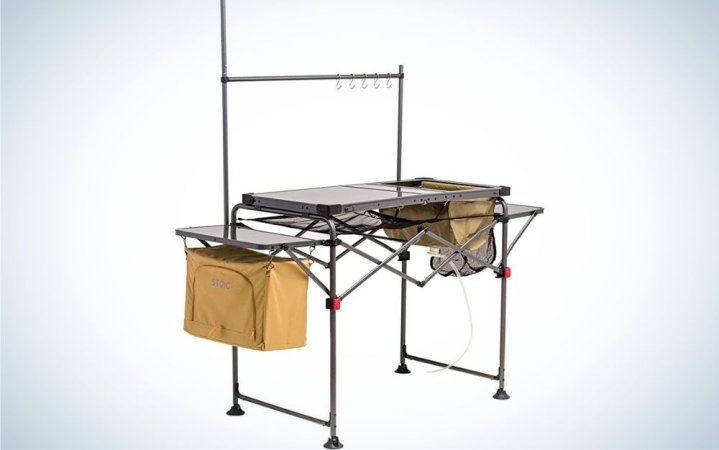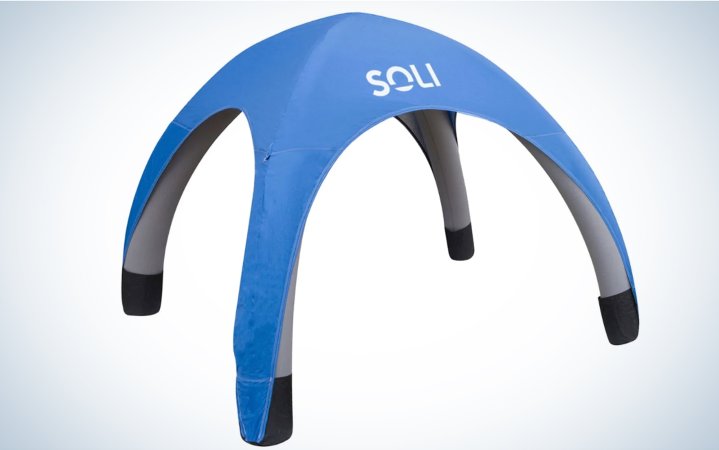We may earn revenue from the products available on this page and participate in affiliate programs. Learn More ›
Part of the fun of getting geared up for a new season is picking out a few new pieces of camping gear to take to the campground. But sifting through the dozens—sometimes hundreds—of new offerings each season can also be daunting. To help you narrow down this selection process, Outdoor Life writers have been testing tents, mattresses, kitchens, grills, hammocks, and more for months. Here are our picks of the best camping gear available today:
- Best Tent: Eureka Copper Canyon LX8
- Best Hammock: ENO DoubleNest
- Best Sleeping Bag: Klymit Wild Aspen Rectangle
- Best Mattress for Couples: Sea to Summit Comfort Deluxe Self-Inflating Sleeping Mat
- Best Cot: Decathlon Quechua Folding Camping Cot
- Best Camp Kitchen: Stoic Portable Camp Kitchen Island
- Best Grill-Stove Combo: Camp Chef Rainier 2X
- Best Cooler: RovR RollR
- Best Canopy: Soli Air Canopy
- Best Toilet: Thetford Porta Potti 135
How OL Tests the Best Camping Gear
The camping gear in this article was chosen after months of research and testing by the Outdoor Life gear team and our contributors. Included are selections from our test of the best camping tents, the best camping hammock, the best camping mattress for couples, the best camp kitchens, and the best grill-stove combos. All of our testing involved hands-on, in-the-field experiences, with each product and its competition.
Best Camping Gear: Reviews & Recommendations
Best Tent: Eureka Copper Canyon LX8
Key Features
- Dimensions: 13 feet x 10 feet
- Height: 7 feet
- Weight: 33.5 pounds
- Poles: 10
- Packed Size: 11 inches x 29 inches
- Doors: 2
- Windows: 6
Pros
- Great livable space on the interior
- Withstood both rain and wind on the testing trip
- Lots of doors and windows
Cons
- Complicated setup
- Heavy
A great family tent is one that provides enough space for everyone to spread out and provides ample protection against the elements—rain and wind, in particular. The Eureka Copper Canyon LX8, reviewed as part of our test of the best 8 person tents, accomplishes both of those goals at a price point that is half of some major competitors.

Despite the strong winds and intermittent rain that struck during testing, the Copper Canyon LX8 bounced back quickly without damaging the fiberglass poles. At one point the rainfly came unattached at a corner, but after a member of the testing group re-secured it with the provided velcro tabs (which I forgot to do during the initial setup), it wasn’t a problem. And the rainfly turned out to be plenty of protection against overnight rain once the windows were zippered up.

Even better, the ceiling height (seven feet) combined with the near-vertical walls on this one made it easy for the 6-foot 1-inch member of the family to walk around without having to stoop at the edges.

The only downside to this tent is that it is an usually complicated setup. Three fiberglass poles crisscross the ceiling and then connect to six steel poles at each end to form the walls (the tenth pole creates the awning over the doorway). The directions for this were reasonably easy to follow—it just took a while. While I was able to set up the body of this tent by myself, a second (taller) person was needed to add the rainfly.
Best Hammock: ENO DoubleNest
Key Features
- Weight: 19 ounces
- Weight limit: 400 pounds
- Dimensions: 9 feet 6 inches x 6 feet 4 inches
- Suspension straps not included
- Material: 70D nylon
Pros
- Durable material
- Easy setup
Cons
- Comparatively low weight limit for a two-person hammock
ENO’s DoubleNest was easily the most straightforward camping hammock to hang up that I tested when reviewing the best camping hammocks. Like other models, the instructions were minimal and easily fitted on a hangtag tucked inside the stuff pouch, yet they were also specific enough—including details about diagonal lay and the correct angle of the suspension system—to provide this first-time user with enough information to get the most out of the hammock.

The fabric of the DoubleNest is thicker than the others I tested, and that durability increased my confidence in the hammock’s support. Once I sat down and swung my legs inside, I was surprised at how comfortable and secure I felt. The Doublenest had the smallest profile of the best camping hammock picks, and it would easily fit into a daypack for someone looking to lounge and enjoy the view at their destination.
Best Sleeping Bag: Klymit Wild Aspen Rectangle
Best Overall
Klymit Wild Aspen
Key Features
- Rated to 20 degrees; OL recommends this for temps as low as 40 degrees
- Material: Polyester shell, synthetic fill
- Width: 34 inches
- Length: 74 inches
- Packed Size: 20 inches x 8.5 inches
- Also available as a mummy bag
Pros
- Small packed size
- Affordably priced
- Warm enough for shoulder season camping
Cons
- No hood
At first glance, the Klymit Wild Aspen Rectangle might remind you of the sleeping bag you had as a kid, but don’t be fooled. This one has important upgrades to make it camping ready. It uses a high-quality synthetic fill that provides an impressive amount of insulation—especially given its relatively svelte packed size (which can become even slimmer with some strategic tugs on the stuff sack’s compression straps). And it manages all that while still being affordably priced. If you’re looking to outfit the family with sleeping bags before next summer’s adventures, this is a great place to start.
Read Next: The Best Sleeping Bags for Camping
My only complaint with the Klymit Wild Aspen Rectangle is that, unlike the mummy versions of the same bag, the rectangular version does not come with a hood option.
Best Mattress for Couples: Sea to Summit Comfort Deluxe Self-Inflating Sleeping Mat
Key Features
- R Rating: 6.5
- Height: four inches
- Weight: 9 pounds, 13 ounces
- Size: 51 inches x 79 inches
- Shell Fabric: 30D polyester upper, 75D polyester base
- Packed Size: 27 inches x 9 inches
- Lifetime Warranty
Pros
- Extremely comfortable
- Warm
- Durable
Cons
- Expensive
- Bulky
- Confusing valve design
Out of all of the best camping mattresses for couples that I tested, the Sea to Summit Comfort Deluxe came closest to the feel of my mattress at home. Its four inches of foam not only made this pad super cushy but also provided substantial warmth. The 6.5 R rating here was more than enough to protect me from the cold of the ground while sleeping outside in temps that fell to the 40s, which is why it’s a no-brainer pick when it comes to the best camping gear. I also appreciated that I was able to inflate this camping mattress to my preferred level of firmness after the self-inflation period was complete.

Like all self-inflating mattresses, it’s best to keep your expectations low the first time you try to inflate. During testing, the Sea to Summit Comfort Deluxe did not inflate at all when left open for an hour—typical for self-inflating mattresses during the first use and after lengthy storage periods. Subsequent attempts to allow the air mattress to self-inflate went much better, but still expect to do some significant top-off.
The valve for the Comfort Deluxe is also somewhat confusing if you are used to the valves seen on their air sleeping pads. The valve that I thought I was supposed to use to dump out all the air from the mattress was in fact the valve to self inflate. To deflate the mattress, I had to open the self-inflate valve, flip the toggle around (not twist, which is what the arrow on the toggle initially seems to imply) to the side that said “deflate,” and then reattach it to the valve. But once you get the hang of the setup, this one comes together surprisingly fast for a self-inflating sleeping pad.

The dimensions of the Sea to Summit Comfort Deluxe when rolled up are significant—this pad was as big as the 8-person tents that I tested on the same trip. It is also recommended that you store this pad inflated at home to maximize its lifespan, which can be difficult for anyone with limited storage space.
Best Cot: Decathlon Quechua Folding Camping Cot
Best Value
Decathlon Quechua Folding Camping Cot
Key Features
- Size: 74.8 inches long x 25.6 inches wide x 17.7 inches tall
- Weight: 16.5 pounds
- Packed Size: 38 inches long x 5.5 inches wide x 5.5 inches tall
- Weight Limit: 240 pounds
Pros
- Affordable
- Comparatively lightweight
Cons
- Not warm enough for shoulder season conditions or cold sleepers
- Lower weight limit than other picks on our list
I handed the Decathlon Quechua Folding Camping Cot over to some beginner campers at the start of my testing trip of the best camping cots. When I checked back in a short time later, they already had it set up and ready to go. And it’s easy enough to see why: The cot is hassle-free to unfold and includes straight-forward instructions on the inside of the carrying bag. During testing, it was as comfortable as the slightly higher priced Cabela’s camping cot and, for shorter people, the equivalent to the bulkier, higher-priced Escalade. If you’re looking to outfit the entire family with cots (which can run up a hefty price tag), then this one is a no-brainer.
The biggest issue here is the lack of insulation—a common issue among the camping cots I tested. While camping cots protect you from the cold of the ground by raising you up high, cold air flowing back and forth beneath you can still compromise the warmth of your sleeping bag. If you sleep cold or plan to use this cot in shoulder season conditions, consider pairing it with a high R-value sleeping pad like the Therm-a-Rest Basecamp.
Best Camp Kitchen: Stoic Portable Camp Kitchen Island
Key Features
- Included carrying case
- 23 pounds
- Aluminum components
- Includes integrated sink, lantern pole, overhead hooks, zippered pantry, dish-drying net, trash bin
Pros
- Strong aluminum-frame construction and non-slotted tabletop for food prep
- Collapsible design stores easily in durable canvas carrying case
- Multipurpose features, including sink and drain
Cons
- Limited counter space for food prep
- No paper instructions for setup, but fairly intuitive to figure out
- Takes about nine minutes to set up
This all-in-one kitchenette, with lots of bells and whistles, won our test for the best camp kitchens. The writer especially appreciated the moveable overhead hooks that could hang rags and/or pots/pans, which, to her delight, could be used to hang a water reservoir above the sink for dishwashing. She found the sink to be generously sized with an integrated hose for draining, which made for easy dishwashing and disposal of greywater (be sure not to leave a trace and follow campground protocols). The under-the-counter removable mesh shelf was also a perfect dish-drying and storage area that kept spent dishes out of the way.

The writer had no problem storing all of their cookware and dishes in the side canvas storage compartments, and noted that these nooks could also serve as a food pantry. The lantern pole accessory is nice for hanging a camping light for sunrise and sunset kitchen duties. It also had a versatile side mesh bin that served as a trash receptacle.
Even though it boasts 63 inches of workspace, there was less real estate compared to other kitchens in the test. Once a two-burner camp stove was set up next to the integrated sink, it only left 20 inches of prep area on the two non-slotted side tables.
Best Grill-Stove Combo: Camp Chef Rainier 2X
Key Features
- Includes both non-stick grill and flat top griddle inserts
- Combined 18,000 BTUs/hour for both burners
- Push-button ignition
- Three-sided wind screen
- Holds up to a 10-inch pot on burner
- Carry bag
Pros
- Extremely versatile unit
- Included griddle surface
- Carrying case keeps all parts packed together
- Consistent performance even in windy conditions
- Heavy duty stove top surface handles the weight of a full pot of water
Cons
- Heaviest (16 pounds) unit tested
- No channel for grease to drain from griddle
Of all the tested units, this grill stove combo is one of the most well built. While all that extra metal comes with the price of a few extra pounds, if you are looking for a unit that will stand up to the rigors of camping for years to come, this is the stove for you. Even in a stiff breeze, the wind flaps worked well to keep an even flame. And they conveniently locked in place with the stove’s side latches. These were a nice improvement over some of the small clips of the other units.
The non-stick cooking surfaces are easy to clean, and the area under the grill is fully enclosed and smooth, with no nooks or corners, which makes it easy to wipe out with just a paper towel or two.

Cooking breakfast, toasting bread, and even grilling burgers and onions on the included flat top griddle is a breeze. The included carry bag makes transporting the stove easy and makes a handy spot to store the griddle when not in use. While a slide out grease tray would make for easier clean up, it only took a few minutes to wipe out the smooth chamber below the grill grates.
Best Cooler: RovR RollR
Best Overall
RovR RollR
Key Features
- Capacity: 60 quarts (claimed), 52 (measured); 45-quart and 80-quart capacity also available
- Dimensions: 26.5 x 20 x 21 inches (exterior); 19.5 x 10.5 x 12 inches (interior)
- Weight: 49.5 pounds
- IGBC-certified (bear-proof locks sold separately)
Pros
- Best-in-class ice retention
- Wheels make it easily portable
- Excellent drainage
Cons
- Expensive compared to others in our test
- Poor interior volume to exterior volume ratio; interior volume does not match manufacturer-provided measurements of the interior
The RovR RollR was easily the flashiest cooler in my test of the best camping coolers, with bulky 9-inch wheels, a roller handle, and a convenient pop-top storage bin. But don’t let all the extras fool you: This cooler performed exceptionally in my ice retention test. It took almost two days for a single bag of ice to melt.
The extras in this cooler should be especially appealing to anyone planning to travel into more rugged terrain. The 9-inch diameter wheels made this easier to pull over rooty trails (even given its hefty 50-pound weight). The sitting pad on top of the cooler can also be converted to a stash bin for all the extras you want to transport to your destination. For campers heading farther afield, there’s even an attachment (sold separately) to attach the cooler to your bike.
One unique feature of this cooler is the interior design: The wheels create a step-down shelf on the far side. At first glance, you might think the odd dimensions would make it difficult to pack food efficiently, but its utility becomes clear as the ice starts to melt: the meltwater drips down into the pocket, where it’s easily siphoned off using the drainage port. This helps to keep your food from getting soggy in a pool of melted ice water. A handy vertical basket (provided with the cooler) can be used to store food on the drainage end of the cooler without immersing your perishables, and helps to create a barrier to stop the rest of your food from sliding over. Though unusual, it’s a well-thought-out design.
The biggest drawback to the RovR RollR is the price. It was the most expensive option at the time of testing, which was especially noticeable since its volume when measured out was less than the claimed 60 quarts. Some users may also find the rubber latches somewhat difficult to manage—it took some elbow grease for me to pull them down and up while checking the ice during testing. The drainage similarly caused some issues at first, with ice water leaking out onto the floor, but once I cranked it down the leakage stopped—my takeaway is that straight out of the box the drainage port simply isn’t closed all the way.
All in all, if you’re willing to spend extra to upgrade your camping experience, this is an excellent choice.
Best Canopy: Soli Air Canopy
Best Inflatable
Soli Air Canopy
Key Features
- Weight: 17 pounds
- Size: 10 by 10 feet
- Center Height: 8 feet
Pros
- Comes with a backpack for easy storage and transportation
- Hardcore stakes
- Includes a shade wall and air pump
- Easy to setup
Cons
- Not as tall
This canopy tent is inflatable, and a unique shape. Though I think it is superior to similarly priced traditional pop-ups for a few reasons. In extreme conditions there is no metal to bend or snap, and as long as the Soli Air Canopy is staked down, it isn’t going anywhere. It’s also extremely versatile so that you can adjust the angle or drop it down by tightening the guy lines in the event of foul weather. The arches also make it harder to bump your head and even if you do, the squishy inflatable hurts a lot less.

The Soli Air Canopy inflates easily with the included rechargeable air pump in just a few minutes. Thanks to the flexible nature of the inflatable you can move the legs in or out for an optimal angle. Though in order to fully zip the included shade wall into place, the legs have to be a certain distance apart. I would recommend staking down the arm with the inflation valve first, then inflating the tent and zipping the wall before finalizing your stake placement.
Read Next: The Best Canopy Tents
The included stakes are thick plastic corkscrews that I’m sure work great on a sandy beach. However in dry dirt, they were difficult to screw in and would only go down half-way, but they still did the trick in mild conditions. I switched to heavy duty tent stakes when camping in the high desert. Over the course of testing, this pop-up saw wind, hail, rain, and sun. It stood up to all the elements well. At night I had to re-inflate the arms thanks to a drop in temperature, but it was quick and easy. —Ashley Thess
Best Toilet: Thetford Porta Potti 135
Best for small spaces
Key Features
- 2.6-gallon fresh water tank
- 2.6-gallon holding tank
Pros
- Lightweight
- One button release for holding tank
- Seat and lid can be removed for cleaning
- Hand pump for flushing
- One carrying handle
- Stylish look (Gray bottom/white top)
Cons
- No level indicator
- Low height (not standard toilet height)
The Thetford was the most compact and lightest toilet I tested at just under 8 pounds. It can fit in small spaces and would be ideal for a van or campsite.
The top of the toilet connects to the base, which is the holding tank, and with a simple one-touch lever, it detaches very easily. The holding tank has a sealed valve and pour-out spout that rotates for easy emptying. The holding tank also has sealed pullout valve, so when not in use, you can lock in the odors along with a vent button to release a small amount of air pressure inside the tank. Both the our lids (intake and outtake) have caps with a gasket for a secure fit. One key feature I love is that the toilet lid can latch and snap shut.
Read Next: The Best Camping Toilets
The overall footprint of the toilet is smaller in height than a regular toilet, as it stands only 12 inches off the ground. The base has a storage area where you can keep toilet chemicals or a small roll of toilet paper. Bonus: Optional carrying bag can be purchased for $23.—Justin La Vigne
Things to Consider Before Buying Camping Gear
Budget
Some great pieces of camping gear can cost thousands of dollars, while others are relatively inexpensive. Before choosing what you want to spend this year’s budget on, consider what items in your gear closet are most in need of an upgrade. What is starting to wear out? What did you purchase a decade or more ago that would benefit from an upgrade? And what most limits your ability to enjoy the outdoors?
Space
Beyond budget, one of the biggest constraints with camping gear is space, so consider if the amount of space a new piece of gear will take up in your vehicle will help to maximize your camping experience.
Longevity
Before you drop some of your hard-earned money on a new piece of camping gear, it’s important to know if it is a solid long-term investment. The Outdoor Life gear team looks carefully at the durability of the products we test to help you make you this decision.
Making Space in Your Gear Closet
Don’t just toss that older piece of gear you are replacing in the trash; see if there are friends, family, or neighbors that might benefit from it. Many of us started our gear closets with the castoff of older, more experienced campers, and handing down gear that you’ve outgrown to the next generation of campers is an important tradition to uphold.
FAQs
Camping gear can cost next to nothing if it’s a hand me down or purchased secondhand to thousands, or even tens of thousands of dollars.
Do not bring anything camping that you wouldn’t want to get dirty, dusty, or wet. Beyond that, just about anything can come camping with you as long as you take care, and respect its limitations. Many campers also choose to leave behind a preponderance of electronics so that they can fully enjoy their time recharging in the wilderness.
The most important items to have while camping are a tent (to protect you from the elements), a sleep system (a bag and a mat), appropriate clothes for the conditions you expect to face, and a food preparation strategy, which could involve everything from a full camp kitchen and electric cooler to simple boil-in-bag meals that need nothing more than a backpacking stove.
Final Thoughts
The best camping gear will last you and your family for years. Prioritizing those pieces of gear that will bring the most long-term benefit will help to maximize your time out of doors.
- Best Tent: Eureka Copper Canyon LX8
- Best Hammock: ENO DoubleNest
- Best Sleeping Bag: Klymit Wild Aspen Rectangle
- Best Mattress for Couples: Sea to Summit Comfort Deluxe Self-Inflating Sleeping Mat
- Best Cot: Decathlon Quechua Folding Camping Cot
- Best Camp Kitchen: Stoic Portable Camp Kitchen Island
- Best Grill-Stove Combo: Camp Chef Rainier 2X
- Best Cooler: RovR RollR
- Best Canopy: Soli Air Canopy
- Best Toilet: Thetford Porta Potti 135













